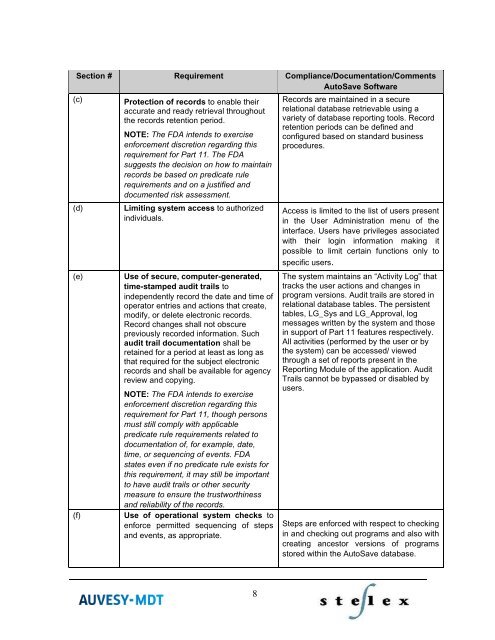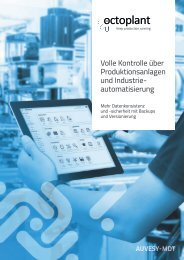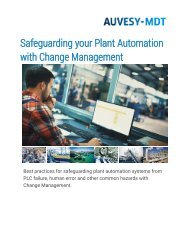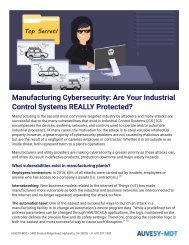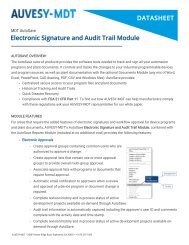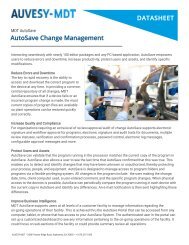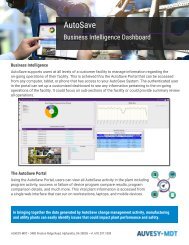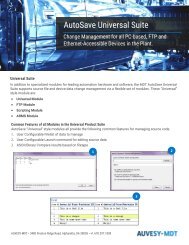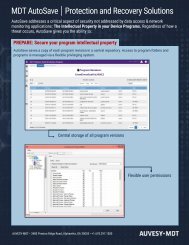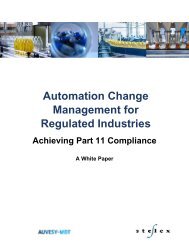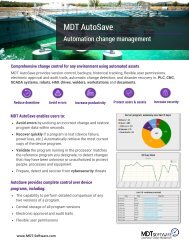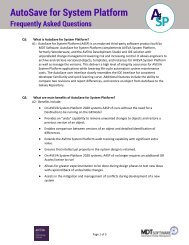White paper - Automation Change Management for Regulated Industries
Achieving Part 11 Compliance
Achieving Part 11 Compliance
- TAGS
- changemanagement
- autosave
Create successful ePaper yourself
Turn your PDF publications into a flip-book with our unique Google optimized e-Paper software.
Section # Requirement Compliance/Documentation/Comments<br />
AutoSave Software<br />
(c)<br />
(d)<br />
(e)<br />
(f)<br />
Protection of records to enable their<br />
accurate and ready retrieval throughout<br />
the records retention period.<br />
NOTE: The FDA intends to exercise<br />
en<strong>for</strong>cement discretion regarding this<br />
requirement <strong>for</strong> Part 11. The FDA<br />
suggests the decision on how to maintain<br />
records be based on predicate rule<br />
requirements and on a justified and<br />
documented risk assessment.<br />
Limiting system access to authorized<br />
individuals.<br />
Use of secure, computer-generated,<br />
time-stamped audit trails to<br />
independently record the date and time of<br />
operator entries and actions that create,<br />
modify, or delete electronic records.<br />
Record changes shall not obscure<br />
previously recorded in<strong>for</strong>mation. Such<br />
audit trail documentation shall be<br />
retained <strong>for</strong> a period at least as long as<br />
that required <strong>for</strong> the subject electronic<br />
records and shall be available <strong>for</strong> agency<br />
review and copying.<br />
NOTE: The FDA intends to exercise<br />
en<strong>for</strong>cement discretion regarding this<br />
requirement <strong>for</strong> Part 11, though persons<br />
must still comply with applicable<br />
predicate rule requirements related to<br />
documentation of, <strong>for</strong> example, date,<br />
time, or sequencing of events. FDA<br />
states even if no predicate rule exists <strong>for</strong><br />
this requirement, it may still be important<br />
to have audit trails or other security<br />
measure to ensure the trustworthiness<br />
and reliability of the records.<br />
Use of operational system checks to<br />
en<strong>for</strong>ce permitted sequencing of steps<br />
and events, as appropriate.<br />
Records are maintained in a secure<br />
relational database retrievable using a<br />
variety of database reporting tools. Record<br />
retention periods can be defined and<br />
configured based on standard business<br />
procedures.<br />
Access is limited to the list of users present<br />
in the User Administration menu of the<br />
interface. Users have privileges associated<br />
with their login in<strong>for</strong>mation making it<br />
possible to limit certain functions only to<br />
specific users.<br />
The system maintains an “Activity Log” that<br />
tracks the user actions and changes in<br />
program versions. Audit trails are stored in<br />
relational database tables. The persistent<br />
tables, LG_Sys and LG_Approval, log<br />
messages written by the system and those<br />
in support of Part 11 features respectively.<br />
All activities (per<strong>for</strong>med by the user or by<br />
the system) can be accessed/ viewed<br />
through a set of reports present in the<br />
Reporting Module of the application. Audit<br />
Trails cannot be bypassed or disabled by<br />
users.<br />
Steps are en<strong>for</strong>ced with respect to checking<br />
in and checking out programs and also with<br />
creating ancestor versions of programs<br />
stored within the AutoSave database.<br />
8


